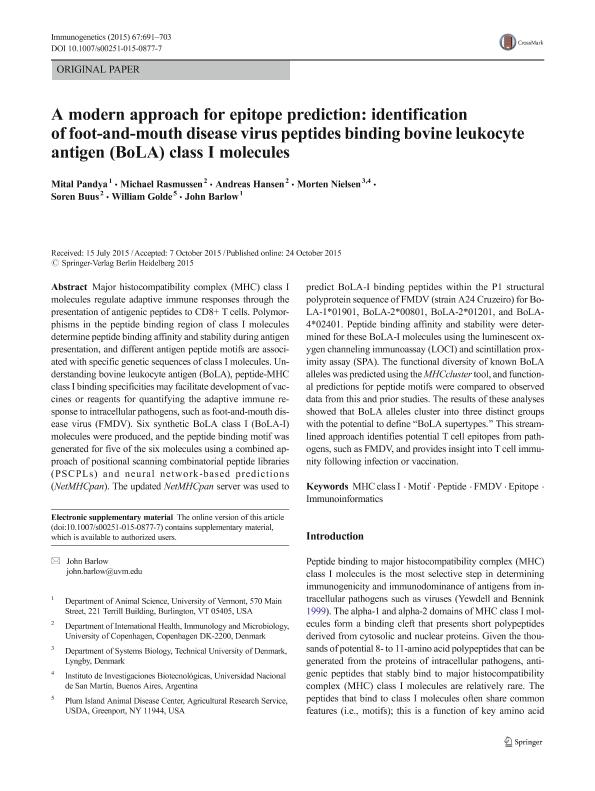Artículo
A modern approach for epitope prediction: identification of foot-and-mouth disease virus peptides binding bovine leukocyte antigen (BoLA) class I molecules
Pandya, Mital; Rasmussen, Michael; Hansen, Andreas Martin; Nielsen, Morten ; Buus, Søren; Golde, William T.; Barlow, John
; Buus, Søren; Golde, William T.; Barlow, John
 ; Buus, Søren; Golde, William T.; Barlow, John
; Buus, Søren; Golde, William T.; Barlow, John
Fecha de publicación:
11/2015
Editorial:
Springer
Revista:
Immunogenetics
ISSN:
0093-7711
e-ISSN:
1432-1211
Idioma:
Inglés
Tipo de recurso:
Artículo publicado
Clasificación temática:
Resumen
Major histocompatibility complex (MHC) class I molecules regulate adaptive immune responses through the presentation of antigenic peptides to CD8+ T cells. Polymorphisms in the peptide binding region of class I molecules determine peptide binding affinity and stability during antigen presentation, and different antigen peptide motifs are associated with specific genetic sequences of class I molecules. Understanding bovine leukocyte antigen (BoLA), peptide-MHC class I binding specificities may facilitate development of vaccines or reagents for quantifying the adaptive immune response to intracellular pathogens, such as foot-and-mouth disease virus (FMDV). Six synthetic BoLA class I (BoLA-I) molecules were produced, and the peptide binding motif was generated for five of the six molecules using a combined approach of positional scanning combinatorial peptide libraries (PSCPLs) and neural network-based predictions (NetMHCpan). The updated NetMHCpan server was used to predict BoLA-I binding peptides within the P1 structural polyprotein sequence of FMDV (strain A24 Cruzeiro) for BoLA-1*01901, BoLA-2*00801, BoLA-2*01201, and BoLA-4*02401. Peptide binding affinity and stability were determined for these BoLA-I molecules using the luminescent oxygen channeling immunoassay (LOCI) and scintillation proximity assay (SPA). The functional diversity of known BoLA alleles was predicted using the MHCcluster tool, and functional predictions for peptide motifs were compared to observed data from this and prior studies. The results of these analyses showed that BoLA alleles cluster into three distinct groups with the potential to define “BoLA supertypes.” This streamlined approach identifies potential T cell epitopes from pathogens, such as FMDV, and provides insight into T cell immunity following infection or vaccination.
Palabras clave:
Epitope
,
Fmdv
,
Immunoinformatics
,
Mhc Class I
,
Motif
,
Peptide
Archivos asociados
Licencia
Identificadores
Colecciones
Articulos(IIB-INTECH)
Articulos de INST.DE INVEST.BIOTECNOLOGICAS - INSTITUTO TECNOLOGICO CHASCOMUS
Articulos de INST.DE INVEST.BIOTECNOLOGICAS - INSTITUTO TECNOLOGICO CHASCOMUS
Citación
Pandya, Mital; Rasmussen, Michael; Hansen, Andreas Martin; Nielsen, Morten; Buus, Søren; et al.; A modern approach for epitope prediction: identification of foot-and-mouth disease virus peptides binding bovine leukocyte antigen (BoLA) class I molecules; Springer; Immunogenetics; 67; 11-12; 11-2015; 691-703
Compartir
Altmétricas



